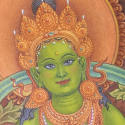Description
Green Tara Paubha is handpainted in Nepal. Green Tara is sitting in the lotus throne surrounded by deities and buddha.
Green Tara is regarded as the spiritual consort of Amoghasiddhi, the Dhyani Buddha. Green Tara is portrayed similar to that of the White Tara. One can find the difference only in her left hand which holds a half-closed lotus or water – lily flower with long petals which is often blue. In the Lamaeist Tradition, Tara is incarnated in all good women.
Green Tara is also to have a mortal base in historic persons of the Nepali and Chinese princess who married the great king Srong – Tsong Gampo and was credited with the introduction of Buddhism to Tibet and China.
Green Tara vowed
“until Samsara is empty, I shall work for benefit of sentient beings in a woman’s body”.
Green Tara is worshipped because she brings all good women.
This Painting is hand-painted with water mineral colors, stone colors by Newari artists living in Bhaktapur Nepal.
Green Tara symbolizes the female side of wisdom activity in our mind and is basically an emanation of the air element (Amoghsiddhi Buddha). She is also called ‘Mother of All Buddhas’ and has many peaceful and wrathful forms.
It creates a spiritual environment and inspires you to be more compassionate kind and even encourages you to do meditate or do your prayers with even more dedication and grace. You can place this thangka on the walls when you are doing Tara pooja or reciting Tara mantras.
Attributes of Green Tara Newari Thangka Painting
- Hand-painted on cotton canvas
- Dimensions: 45*60 cm
- Materials: Cotton Canvas, Poster color, Mixed Gold
- Skill and Origin: Handmade in Nepal
- Category: Newari Thangka paintings, Spirituality
- Use: Meditation, decoration, gift
Introduction of Green Tara
The iconography of Green Tara
- The Buddha Statue
- The Body of teachings
- The Principles of the Universe
What is Paubha?
Paubha is a traditional religious painting made by the Newar people of Nepal.
Paubhas depict deities, mandalas or monuments, and are used to help the practitioner meditate. The Tibetan equivalent is known as Thangka.
What is the difference between Paubha and Thangka?
Newar style after the 13th century reflected developments in illustrated manuscript painting, which was an earlier tradition, dating from the 11th century; the Newar style changed little until the 17th century.
One of the special features of Newar Paubha is that the central figure occupies an ornate frame, an elaborate arch or a torana dvara, formed by the head of the garuda or Tsepu or Kirtimukha, a mythical creature of Nepal. Holding two snakes. It is surrounded by much smaller subsidiary figures.
The profuse use of red color in a softer tone than the red used by Tibetans.
Designs in the aura of the main deity are much simpler than in Tibetan paintings.
The background is filled with flowers and creeping plants in early Newar paintings.
The blank spaces in the background contain simple designs of flowers and long leaves.
The deities are painted with fine line drawing in Newar paintings.
The inclusion of white flowers, large leaves, mountains, stupas, clouds, temples, and monasteries in background scenes is found in Tibetan compositions, whereas there were no background elements in early Newar paintings.
The painted surface is divided into sections. In the larger upper part, the main divinities and their acolytes are depicted, while the lower part is usually smaller in size, and filled with depictions of sponsors or donors. Also women are graphically separated from men, each appearing on opposite sides of the central divinity or sacrificial fire. This grouping by gender is characteristic of near painting.
Only after 17-18th centuries did Nepalese artists began to paint background scenes.
The portrayal of Tantric deities’s wrathful expression is more vigorous in Tibetan than in Nepalese paintings.
The painters remain anonymous.
Mughal and Rajput influences appear only during the 17th century
Curly Chinese clouds entered the repertoire of decorative motifs after the 18th century.
In Newari community, Thangka is called as Paubha. In the Tibetan community, the same is known as Thangkas.
Newari Art, Paubha are handpainted by the Newari community living in Kathmandu Nepal which used for meditation and also is displayed during festivals and other special occasions.
Newari art is very fine art which will take 2 to 3 months to complete one paubha.
Most paubhas show Buddhist subjects, but a few have Hindu themes. The paintings are made to earn religious merit both for the artist and the patron.
Newar Buddhists commission artists to paint paubhas which are displayed during festivals and other special occasions.
The traditional painters of paubhas are the Chitrakar caste who are known as Pun in Nepali.
To know more about green Tara please read the article All about Green Tara.
For custom size, design, and please contact us.



















Reviews
There are no reviews yet.